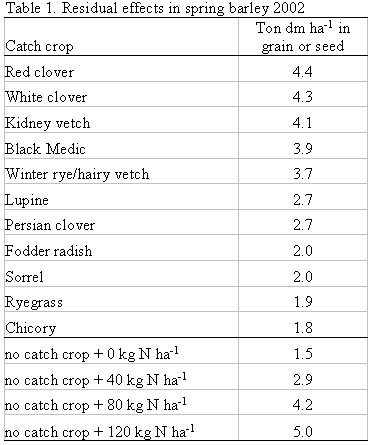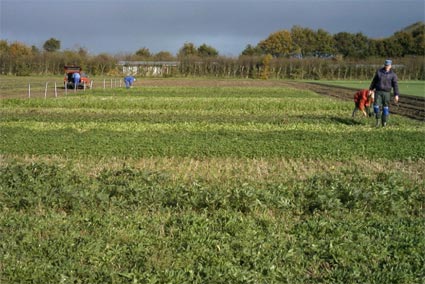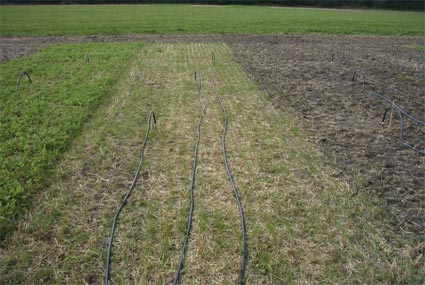Subproject 7
The effect of catch crops on N and K leaching and crop production, with focus on coarse sandy soils
Participants
Margrethe Askegaard, Dept. Agroecology, Danish Institute of Agricultural Sciences, Foulum.
Email: margrethe.askegaard@agrsci.dk
Background
The use of catch crops is a prerequisite for reducing leaching of nutrients on sandy soils. The question is which catch crops to choose. In systems with little or no use of animal manure one option is to use a nitrogen-fixing catch crop.
Activities and results
In order to illuminate these questions, we set up some experiments at Jyndevad Experimental Station in 2001. The experiments will terminate in 2004.
We test both N-fixing and non-N-fixing catch crops undersown in spring barley. Plant biomass measured in autumn 2001 varied from 400-100 kg DM/ha in the non-fixing crops to 1000-2500 kg DM/ha in N-fixing crops. Persian clover was amongst the highest yielding but the species is not hardy and had died down by the beginning of December. The subsequent spring barley crops was not fertilised and was thus nourished solely by the nitrogen fixed by the catch crops. Spring barley following Persian clover yielded 2.7 t grain/ha while the yields following the hardy N-fixing catch crops was 4-4.4 t/ha. Top scorers were white clover and red clover where the yields were equivalent to spring barley fertilised with 80 kg N/ha in mineral fertiliser (Table 1).
In one of the experiments we compare three systems with spring barley: 1) manure and no catch crop, 2) manure with a ryegrass catch crop, and 3) no manure with a grass/clover catch crop. The first results in 2002 gave yields of 2.4 t grain/ha in the system with manure and without a catch crop, while the two systems with a catch crop both gave approximately 3 t/ha. The grass/clover has thus been able to compensate for the pre-crop effect of ryegrass and the addition of manure. N in manure was approximately 70 kg/ha.
A principal factor is the ability of the catch crop to take up nitrogen and other nutrients that would otherwise have been leached. We installed ceramic suction cups in several of the plots and will therefore at some point be able to report on the differences in the ability of N-fixing and non-N-fixing catch crops to reduce leaching.

Figure 1
Sampling in catch crops 1 November 2002

Figure 2
Measurement of N and K leaching in spring and winter from suction cups installed at 80 cm depth. Soil water drains through the hoses on the ground.

Publications in Danish
Askegaard M. 2002. Efterafgrøder på sandjord. Økologisk Jordbrug, 275, 6.
Thomsen H. 2003. Cikorie kan drille på sandjord.Økologisk Jordbrug, 286, 8.
Askegaard, M., Thomsen, H.C., Olesen, J.E. og Rasmusen, I.A. 2004. Resultater med efterafgrøder i økologiske forsøg – hvordan kan disse resultater udnyttes på økologiske og konventionelle bedrifter. Planteproduktion 2004, Herning, Månedsmagasinet Mark, 1, 141.
Planned publications
Askegaard and Eriksen, 2004. Leaching of nitrate, sulphate and potassium on a coarse sandy soil as affected by different catch crops.
Askegaard, 2004. The pre-crop effect of different catch crops on a coarse sandy soil.
Askegaard og Thomsen, 2004. Fokus på screeningsforsøget, 2003/04.Grøn viden (In Danish).
|